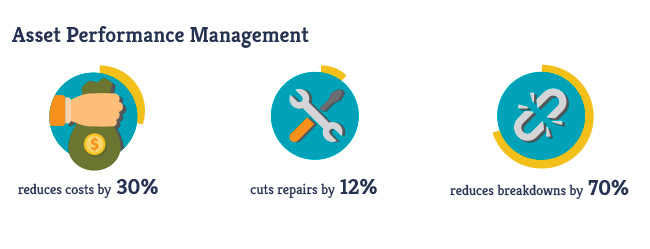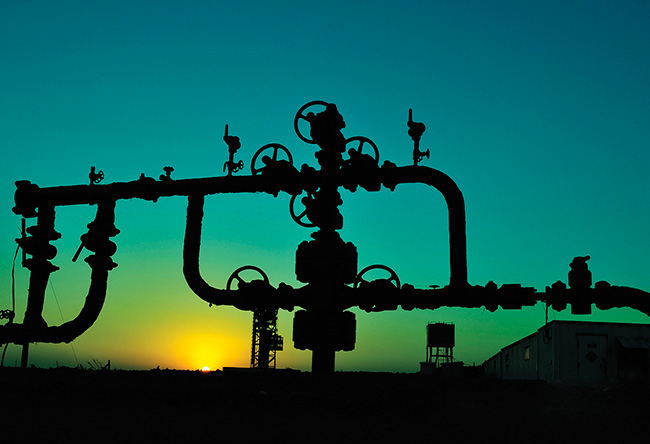Predicting Failure: Asset performance management foretells equipment breakdown, avoids costly downtime
- Published: Wednesday, 02 September 2015
- Author: Gordon Cope
Electrical submersible pumps (ESPs) are an essential component of crude production. Over 130,000 EPSs are in use around the world in high-asset wells, accounting for approximately 60 per cent of the world’s oil production.
But ESPs can also fail dramatically, taking down tens of thousands of barrels per day through lost production until they can be fixed. Clearly, being able to predict when they are going to crash—and being able to swap them out beforehand—is valuable information.
 (ILLUSTRATION: ©ISTOCK.COM/KMLMTZ66)
(ILLUSTRATION: ©ISTOCK.COM/KMLMTZ66)
Apache operates thousands of ESPs in North America and around the world. Thanks to real-time monitoring, the Texas-based company has collected a huge volume of ESP performance data, along with completions, subsurface characteristics and geological information. Apache worked with GE to analyze the hybrid data in order to pick the right pump for the right well, then to help pumps last longer, and finally, to predict when they might fail.
In the end, the process helped Apache avoid significant loss of production, a benefit that could be passed on to the industry as a whole. According to the company, a one per cent improvement in global ESP performance would provide over a half-million additional barrels of oil per day. Even at today’s low prices, that amounts to billions of dollars per year.
Apache’s success came from leveraging a hardware and software application that is generically referred to as asset performance management (APM). Real-time monitors transmit a spectrum of data to central facilities where they are processed with software that uses big data analytics to search out patterns invisible to the human eye.
Various terms are used to describe the process, including artificial intelligence, machine learning and machine intelligence. At its most generic, software developed around specialized algorithms takes a wide array of space and time data—not only quantitative data, such as temperatures and pressures, but language, images, speech and metadata—and makes sense of it all.
According to a GE-Accenture study, APM can reduce maintenance costs by 30 per cent, cut scheduled repairs by 12 per cent and reduce breakdowns by up to 70 per cent.
“The work we do with customers shows that big data analytics can make a difference,” says Orvil Smith, the Canadian general manager of GE Oil & Gas Measurement and Control. “When an ESP fails, it can take a long time to get the well back up. If you can anticipate a problem before failure, know when to turn it down and order new replacement parts, then it can avoid a lot of down days.”

APM is just one dimension of a revolution underway across all facets of the economy. Smart devices, ranging from electric meters to pipeline substations, are gathering data and transmitting it via the internet. As the Internet of Things (IoT) quickly permeates all walks of life, vast amounts of data are being generated. According to Cisco, there are already 25 billion smart devices connected to the internet. By 2020, that number is expected to double.
Already, smart devices are ubiquitous in the utility market. Bit Stew, an APM firm based in San Francisco, began operations in California a decade ago, right when utilities were beginning to address smart meters and distributed energy sources. The founders felt that the solutions for connecting smart machines were inadequate, and developed their proprietary Mix Core platform and Mix Director application.
“Bit Stew chose the utility market because they were just entering the usage of smart meters and digital-enabled substations, so there was a plethora of data available,” says Franco Castaldini, vice-president of Bit Stew Systems.
Bit Stew helped one of its clients, BC Hydro, develop an APM system. “We aided them with their smart meter roll-out,” says Castaldini. “Our software originally supplied 100 per cent visibility to meter performance, faulty machines and installation errors.”
Since then, Bit Stew has worked with BC Hydro to augment the APM system, adding new abilities. “We now aid in the management of operations, looking at technical issues, theft of energy, and faults.”
The ability to expand APM into other processes is almost limitless. SoCal Gas, the largest gas distribution company in the U.S., needed to beef up its safety response service. “A few years ago, there was a tragedy in the [San Francisco] Bay area, and there is huge sensitivity to gas distribution,” says Castaldini. (In 2010, a 30-inch gas pipeline owned by Pacific Gas & Electric exploded in San Bruno, a San Francisco suburb, killing eight people and destroying almost 40 homes; PG&E was subsequently fined US$1.6 billion for safety violations.)
SoCal was searching for a way to increase public safety, and asked Bit Stew to help them build a better alarm system. “When it comes to alarms, there are a large number of false positives, and this leads to crew fatigue,” says Castaldini. “We helped them connect crew management, construction operations and alarm response. Now, all information is on a single pane of glass.”
 (PHOTO: BIT STEW SYSTEMS)
(PHOTO: BIT STEW SYSTEMS)
VALUE TO THE OIL AND GAS SECTOR
Already, the oil and gas sector is creating immense volumes of data with smart devices. Operators calculate that monitors on a 3,000-kilometre gas pipeline generate 30 terabytes of data every month, which is triple the amount of information stored in the Library of Congress.
Taking lessons learned from utilities and other sectors, companies are looking at a range of ways to integrate APM and its offshoots into the oil and gas industry. Recently, Bit Stew conducted a downtime proof-of-concept for drillships.
“The most common cause of down- time is when an asset fails and there is an inefficiency of response,” says Castaldini. “The replacement part is not in inventory so there is lost time while the OEM [original equipment manufacturer] supplies a part or the operator searches for a replacement on another ship.”
Bit Stew’s algorithms allow the driller to analyze their level of risk through condition-based maintenance based on actual performance details. “It gives you a visibility to parts inventory that allows a faster response.”
Bit Stew’s first oil and gas sector APM-related application is designed to maintain pipeline integrity. “The pipeline integrity application looks at the flow, pressure, vibrations and valves, and geospatially visualizes everything in one place,” says Castaldini. “You can then integrate weather, fire and seismic events so that you can understand the risk to assets and take action. It improves the efficiency of response to events.”
Ayata Prescriptive Analytics, based in Houston, is one of the pioneers of incorporating a wide variety of information—from gauge data to videos, images, text and sound—into analytics. Ayata breaks analytics down into three categories: descriptive analytics (what is happening, and why); predictive analytics (what will happen); and prescriptive analytics (how can we improve what will happen in the future).
According chief executive officer Atanu Basu, the company is working with Chevron, Apache and other oil and gas firms to make developing unconventional resources safer and more efficient. Ayata’s application analyzes 3-D seismic data, real-time drilling logs, fracture pressures, water use, casing information and production statistics. By combining all the available data sets with prescriptive analytics, the company claims that operators can devise better decisions that look much further ahead, as opposed to the current practice of reviewing data and making incremental improvements on the next well.
Of course, all innovation comes with a price tag. “The cost of a pilot program is in the low six figures, and deployment into the entire infrastructure is in the seven-figure range,” says Castaldini. “With utilities, we aim for a three to five times ROI [return on investment] in the first five years. For new sectors, we aim for a seven to 10 times ROI in the first five years.”
APM-related applications can be installed relatively quickly, however. “In the utilities sector, we can go from original data to a pilot application in under four weeks,” says Castaldini. “In the O&G [oil and gas] sector, we are currently looking at three months, but we expect that to decrease as we co-develop applications and get a better understanding of the sector needs.”
THE FUTURE
Using APM to monitor equipment, schedule maintenance and enhance safety is merely scratching the surface. GE has been offering such services to oil and gas clients for several years, and is now engaged in stretching the boundaries. “GE is working with our customers in O&G to evolve big data analytics to go beyond equipment management and to optimize the entire production process,” says Darren Massey, program leader, Customer Innovation Centre, at GE Canada Global Growth and Operations.
“Any knowledgeable person in the O&G sector knows that when they see a pump gauge pass the red line, the pump is going to burn out. What big data analytics does is look at a wider range of available data to find patterns that are not as obvious to extend the life of that pump but also optimize the way it operates to get the most production out of it.”
One of the aspects that GE is exploring is referred to as operational intelligence. “Some operations take place in a closed environment, like a factory, in which processes are well understood and controllable,” says Massey. “But O&G processes take place in the wild with far less homogeneity and consistency. That means it’s harder to optimize, but it also means that there is opportunity to do so. GE believes there is a lot of promise for optimization in O&G. Our customers think so too.”
Developing customized analytics requires a cooperative approach with clients in order to learn the ins and outs of the oil and gas industry. “Business rules and rules of thumb change from operator to operator, so a higher degree of collaboration is involved,” says Massey. “This is very important, and requires some change of thinking.”
What will the longer-term future bring? GE is working on a holistic approach called asset life cycle management that draws in not only every piece of equipment currently being used, but its entire time in service. “We are working on how to get more bang for your buck throughout the cycle of an asset,” says Massey. “You look at the acquisition, and how it tracks through its work, to the point where it needs to be retired and eventually replaced.”
Bit Stew envisions a time when computers will do most of the work. “Ten years from now, we will have come full circle, where software-defined applications help to automate a closed loop,” says Castaldini. “The software will go from solving a higher degree of problems to reaching a higher degree of solutions. Humans will always be involved, but they will be able to focus on high value problems.”
In the meantime, service companies and oil and gas firms can benefit from the knowledge and experience gleaned in other sectors. “For many years, the North American oilpatch has been going through the challenges of dealing with a period of tremendous growth,” says Smith. “Now that conditions have changed, this is the right time to learn to gather data and move it in an efficient way so that it can be analyzed for insight.”
And they can do so in an efficient, cost-effective manner. “Many aspects of the enabling infrastructure necessary for big data analytics have matured,” says Smith. “For instance, the economies of the Cloud now allow us to store, move and analyze data much more efficiently. Historically, this data has been stranded in isolated databases, unable to be related to give big picture insights. O&G professionals have done a lot of work mining data and making operational improvements. What GE is offering is taking this analysis one step further.”
This article is part of a four-part series with sponsorship from GE exploring the Internet of Things and its impact on the oil and gas industry. While GE professionals were interviewed for this story, the company had no involvement in its creation or production.
-NTM-


